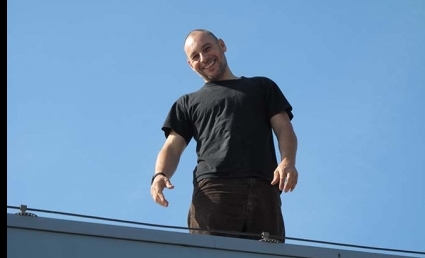Biography
The work of Dutch artist Jeroen Jongeleen, otherwise known as Influenza, is characterized by a distinct stance of dissensus: one that opposes both the superficiality of urban design and the increasing colonization of the street. In a practice that engages with images and public space in a militantly active way, he employes numerous methods and materials - including stickers, plastic bags, spray paints and even the human body itself - in an effort to enliven the banality and sterility of the modern city.
Championing a more liberated public sphere and critiquing the over-regulation of both the city and art, Jongeleen's understated but always ingenious urban interventions are heavily influenced by art movements such as Fluxus (a multidisciplinary group of avant-garde artists in the 1960's), who he sees as the true descendants of the Dada spirit.
He describes his motivation to create art as not about 'decoration or making people happy, but about free speech and movement, about opposition as the essence of a truly democratic society'.
His politically motivated work therefor sets out to illustrate the power and the dynamics of the street, while offering a utopian vision for the future.
*Text Rafael Schacter
Artworks by Jeroen Jongeleen were, among others, included in exhibitions at: Kröller-Müller Museum; Museum Boijmans van Beuningen; BRUTUS; Stedelijk Museum Schiedam and many more.
His works can be found in collections of: Kröller-Müller Museum; LAM; Museum Boijmans van Beuningen; Museum Voorlinden; Stedelijk Museum Schiedam.
Publications:
Jongeleen, Jeroen. The Clilmbing of Buildings, Fences and other Opportunities. Morava, 2010. ISBN: 978-83-926924-1-6


















![Jeroen Jongeleen
The Street As A Forum For Democracy [MODERN DEMOCRACY], 2019, photoprint, 138,5 x 93,5 cm
Photo: Gert Jan van Rooij Jeroen Jongeleen
The Street As A Forum For Democracy [MODERN DEMOCRACY], 2019, photoprint, 138,5 x 93,5 cm
Photo: Gert Jan van Rooij](/images/artist/slider/small/9/0970180001617454158.jpg)

















!['Favourite Misspelling #9 [eror]', 2007, St. Gallen, Switzerland 'Favourite Misspelling #9 [eror]', 2007, St. Gallen, Switzerland](/images/artist/slider/small/9/0518431001397050529.jpg)















!['Dirty Line as a Landscape, Symmetrie', 2008, 1045 x 70 cm, [New York] 'Dirty Line as a Landscape, Symmetrie', 2008, 1045 x 70 cm, [New York]](/images/artist/slider/small/9/0240519001396706337.jpg)
















































